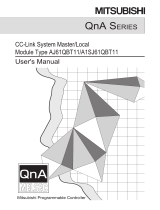
14
TERMS
Unless otherwise specified, this manual uses the following terms.
Term Description
Authentication Class A group of devices and switching hubs compatible with CC-Link IE TSN, classified according to the functions and
performance by the CC-Link Partner Association.
For authentication Class, refer to the CC-Link IE TSN Installation Manual (BAP-C3007ENG-001) published by the CC-Link
Partner Association.
Buffer memory Memory in an intelligent function module to store data such as setting values and monitor values.
For CPU modules, it refers to memory to store data such as setting values and monitor values of the Ethernet function, or
data used for data communication of the multiple CPU system function.
Conformance test Test performed for communications of a CC-Link or CC-Link IE product to ensure their high reliability.
For details, refer to the CC-Link Partner Association website (www.cc-link.org).
Control CPU A CPU module that controls connected I/O modules and intelligent function modules. The multiple CPU system allows the
user to assign the control CPU on a module-by-module basis.
CPU module (built-in Ethernet
port part)
A built-in Ethernet port part of the CPU module (CPU part for the RnENCPU)
Cyclic data transfer processing Processing of a cyclic transmission from its start to finish, performed by all the stations on a single network. The processing
is performed asynchronously with the sequence scan of the CPU module.
The cyclic data transfer processing time varies depending on data volume and the number of transient transmission
requests.
Dedicated instruction An instruction that simplifies programming for using functions of intelligent function modules
Device A memory of a CPU module to store data. Devices such as X, Y, M, D, and others are provided depending on the intended
use.
Engineering tool A tool used for setting up programmable controllers, programming, debugging, and maintenance
General-purpose hub An authentication Class A switching hub authorized by CC-Link Partner Association
Global label A label that is enabled for all program data when creating multiple program data in the project. There are two types of
global label: a module specific label (module label), which is generated automatically by GX Works3, and an optional label,
which can be created for any specified device.
Grandmaster A source device or station to synchronize clocks in the time synchronization via PTP (Precision Time Protocol)
Group No. Number that is assigned for transient transmission to any given stations. By specifying a group of stations as transient
transmission target, data can be sent to the stations of the same group No.
Intelligent function module A module that has functions other than input and output, such as an A/D converter module and D/A converter module
Link device A device (RX, RY, RWr, RWw, LB, or LW) in a module on CC-Link IE TSN
Link refresh Processing of data transfer between link devices of the network module and CPU module devices.
Link refresh is performed in "END processing" of the sequence scan of the CPU module.
Local station A station that performs cyclic transmission and transient transmission with the master station and other local stations
Master station A station that controls the entire network. This station can perform cyclic transmission and transient transmission with all
stations. Only one master station can be used in a network.
Module label A label that represents one of memory areas (I/O signals and buffer memory areas) specific to each module in a given
character string. For the module used, GX Works3 automatically generates this label, which can be used as a global label.
Multicast filter A filter function that selects whether to send cyclic data of multicast mode received by the own station to the subsequent
stations.
Setting parameters for this function are not required because the master station automatically sets the parameters
according to the system configuration.
Multicast mode A communication mode used to send cyclic data to multiple stations
Relay station A station that relays data link to other station with mounting more than one network modules on one programmable
controller.
Remote station A station that exchanges I/O signals (bit data) and I/O data (word data) with another station by cyclic transmission. This
station can perform transient transmission.
Reserved address An IP address reserved for special purposes, defined by RFC 6890. This IP address cannot be used when the
programmable controller is connected via the global IP network.
RnENCPU (network part) A module on the right-hand side of the RnENCPU ( MELSEC iQ-R Ethernet/CC-Link IE User's Manual (Startup))
Safety communications A function to exchange safety data between safety stations on the same network
Safety connection A connection established for safety communication
Safety data Data exchanged through safety communication
Slave station A station other than a master station: a local station, a remote station
SLMP A SeamLess Message Protocol.
This protocol is used to access an SLMP-compatible device or a programmable controller connected to an SLMP-
compatible device from an external device.



























